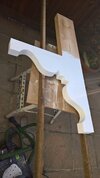Whilst working a friend's today. I needed to shorten a 42mm Iroko worktop that I had previously left loose. I had to remove 18mm from the edge where it meets the old worktop. It was a pretty straight forward profile.

The red lines are the new cuts. I used my festool plunge saw to remove as much as possible and then decided, given that my Festool jigsaw was elsewhere, to use the customer's Mac Alister jigsaw. His (supplied and used blade) would not cut through the wood, so I put a Festool Carvex blade in to it. Even with a decent blade it struggled. I haven't used a cheap jigsaw for years, I had forgotten how awful they can be. I ended up using a chisel to clean the internals of the corner. I have never needed to do that with a decent jigsaw.
The whole experience was horrible. I am sure that I could feel the base flex as I used it. I normally only hold down jigsaw with one hand, on this occasion, I used two.

The red lines are the new cuts. I used my festool plunge saw to remove as much as possible and then decided, given that my Festool jigsaw was elsewhere, to use the customer's Mac Alister jigsaw. His (supplied and used blade) would not cut through the wood, so I put a Festool Carvex blade in to it. Even with a decent blade it struggled. I haven't used a cheap jigsaw for years, I had forgotten how awful they can be. I ended up using a chisel to clean the internals of the corner. I have never needed to do that with a decent jigsaw.
The whole experience was horrible. I am sure that I could feel the base flex as I used it. I normally only hold down jigsaw with one hand, on this occasion, I used two.


